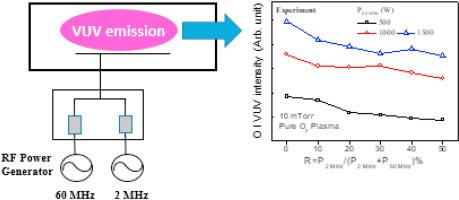Current Applied Physics ( IF 2.4 ) Pub Date : 2021-08-13 , DOI: 10.1016/j.cap.2021.08.003 Duksun Han 1 , Jong-Bae Park 1 , Young-Woo Kim 1 , Deuk-Chul Kwon 1 , Sanghoo Park 1

|
In plasma material processing, vacuum ultraviolet (VUV) emission is released from gas discharges, leading to undesirable results. Energetic VUV photons enable the creation of an electron-hole pair current when their energy is larger than the bandgap energy of the plasma-facing top layer during plasma material processing. For example, the high energy of VUV photons from helium (21.2 eV), argon (11.6 eV), and oxygen (13.6 eV) is sufficient to generate induced currents in SiO2 thin films. These feedstock gases are widely used in many procedures utilizing low-temperature industrial plasmas. Thus, the VUV emission evolution with both the power ratio between high (60 MHz) and low (2 MHz) frequencies and pulse duty ratio of the low-frequency radio frequency (rf) power in a dual-frequency capacitively coupled plasma, which is indispensable in modern plasma etching processes, was investigated. Both the power ratio between high and low frequencies and the pulse duty ratio changed the electron temperature, leading to evolution of the VUV emission intensity.
中文翻译:

双频真空紫外辐射的演变电容耦合等离子体
在等离子体材料加工,真空紫外(VUV)排放从气体放电释放,从而导致不希望的结果。高能VUV光子启用电子-空穴对的电流的创建时,他们的能量是等离子体在材料加工期间比所述面向等离子体的顶层的带隙能量大。例如,来自氦(21.2伏特),氩气(11.6伏特),和氧(13.6 eV)的VUV光子的高能量足以以SiO产生感应电流2薄膜。这些原料气体被广泛使用在利用低温等离子体工业很多程序。因此,在双频电容耦合等离子体,这是高(60兆赫)和低(2兆赫)的频率和低频率的无线电频率的脉冲占空比(RF)功率之间两者的功率比的VUV发射进化在现代等离子体蚀刻工艺不可或缺的,进行了调查。高和低频率和脉冲占空比之间的功率比改变了电子温度,导致VUV发射强度的演化。











































 京公网安备 11010802027423号
京公网安备 11010802027423号